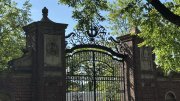We note with sadness the death on May 1, at home in Boston, of William O. Taylor ’54, chairman emeritus of the Boston Globe, where he had served with distinction as publisher. Among his many other pro bono activities, Bill was a member of the Harvard Magazine Incorporated board of directors from 1995 to 2001 (much of that time alongside his classmate, Daniel Steiner ’54, LL.B. ’58)—a critical period when the forces now transforming publishing and the media took form and accelerated. His early insights into these changes regularly informed the magazine’s evolving responses. Even after he was diagnosed with a brain tumor in 2009, Bill remained a magazine incorporator and an informal counselor—roles that we especially remember and value. The Editors
William O. Taylor
William O. Taylor
You might also like
For Campus Speech, Civility is a Cultural Practice
A former Harvard College dean reviews Princeton President Christopher Eisgruber’s book Terms of Respect.
Your Views on Conservatism on Campus, Doxxing, and More
Readers write in about international students at Harvard, the September-October cover, and changes at the Chan School of Public Health.
Your Views on Harvard’s Standoff, Antisemitism, and More
Readers comment on the controversial July-August cover, authoritarianism, and scientific research.
Most popular
Explore More From Current Issue

Open Book: A New Nuclear Age
Harvard historian Serhii Plokhy’s latest book looks at the rising danger of a new arms race.

A Near-Perfect Football Season Ends in Disappointment
A loss to Villanova derails Harvard in the playoffs.






